Annealing Effect on the Structure and Optical Properties of CBD-ZnS Thin Films for Windscreen Coating
Abstract
:1. Introduction
2. Materials and Methods
3. Results
3.1. Structure Analysis
3.2. Optical Analysis
4. Conclusions
Funding
Institutional Review Board Statement
Informed Consent Statement
Data Availability Statement
Acknowledgments
Conflicts of Interest
References
- Amrollahi Bioki, H.; Borhani Zarandi, M. Effects of annealing and thickness on the structural and optical properties of crystalline ZnS thin films prepared by PVD method. Int. J. Opt. Photonics 2011, 5, 121–128. [Google Scholar]
- Chen, R.F.; Yu, J.; Hua, Y.Q.; Xu, R.L.; Liu, H.X. Study of structure and optical properties of magnetron sputtered ZnS thin films by annealing. Appl. Mech. Mater. 2012, 130–134, 1379–1382. [Google Scholar] [CrossRef]
- Bacha, K.B.; Bitri, N.; Bouzouita, H. Effect of annealing parameters on structural and morphological properties of sprayed ZnS thin films. Optik 2016, 127, 3100–3104. [Google Scholar] [CrossRef]
- Khanegahi, B.; Sedghi, H. Effect of Annealing Temperature on Optical Properties of ZnS Thin Films Studied by Spectroscopic Ellipsometry Analysis Method. Int. J. Nano Rech. 2018, 1, 12–17. [Google Scholar]
- Lu, L.; Xu, Z.; Zhang, F.; Zhao, S.; Wang, L.; Zhuo, Z.; Song, D.; Zhu, H.; Wang, Y. Using ZnS nanostructured thin films to enhance light extraction from organic light-emitting diodes. Energy Fuels 2010, 24, 3743–3747. [Google Scholar] [CrossRef]
- Tong, W.; Tran, T.K.; Park, W.; Schon, S.; Wagner, B.K.; Summers, C.J. High-quality ZnS thin-film growth for flat-panel displays. Journal of the Society for Information Display. J. Soc. Inf. Disp. 1996, 4, 325–329. [Google Scholar] [CrossRef]
- Qiu, K.; Qiu, D.; Cai, L.; Li, S.; Wu, W.; Liang, Z.; Shen, H. Preparation of ZnS thin films and ZnS/p-Si heterojunction solar cells. Mater. Lett. 2017, 198, 23–26. [Google Scholar] [CrossRef]
- Tran, N.; Lamb, R.; Mar, G. Single source chemical vapour deposition of zinc sulphide thin films: Film composition and structure. Colloids Surf. A Physicochem. Eng. Asp. 1999, 155, 93–100. [Google Scholar] [CrossRef]
- Djelloul, A.; Adnane, M.; Larbah, Y.; Sahraoui, T.; Zegadi, C.; Maha, A.; Rahal, B. Properties Study of ZnS Thin Films Prepared by Spray Pyrolysis Method. J. Nano-Electron. Phys. 2015, 7, 04045. [Google Scholar]
- Haque, F.; Rahman, K.S.; Islam, M.A.; Rashid, M.J.; Akhtaruzzaman, M.; Alam, M.M.; Alothman, Z.A.; Sopian, K.; Amin, N. Growth optimization of ZnS thin films by RF magnetron sputtering as prospective buffer layer in thin film solar cells. Chalcogenide Lett. 2014, 11, 189–197. [Google Scholar]
- Oliva, A.I.; González-Chan, I.; Rejón, V.; Rojas, J.; Patiño, R.; Aguilar, D. Chemical bath method for ZnS thin films preparation. In Proceedings of the 2010 7th International Conference on Electrical Engineering Computing Science and Automatic Control, Tuxtla Gutierrez, Mexico, 8–10 September 2010; IEEE: Piscataway, NJ, USA, 2010. [Google Scholar]
- Zhang, Z.; Shen, D.; Zhang, J.; Shan, C.; Lu, Y.; Liu, Y.; Li, B.; Zhao, D.; Yao, B.; Fan, X. The growth of single cubic phase ZnS thin films on silica glass by plasma-assisted metalorganic chemical vapor deposition. Thin Solid Films 2006, 513, 114–117. [Google Scholar] [CrossRef]
- Ashith, V.; Rao, K.G. Structural and optical properties of ZnS thin films by SILAR technique obtained by acetate precursor. IOP Conf. Ser. Mater. Sci. Eng. 2018, 360, 012058. [Google Scholar] [CrossRef]
- Allouche, N.K.; Ben Nasr, T.; Guasch, C.; Turki, N.K. Optimization of the synthesis and characterizations of chemical bath deposited Cu2S thin films. Comptes Rendus Chim. 2010, 13, 1364–1369. [Google Scholar] [CrossRef]
- Feitosa, A.; Miranda, M.A.R.; Sasaki, J.M.; Araújo-Silva, M.A. A new route for preparing CdS thin films by chemical bath deposition using EDTA as ligand. Braz. J. Phys. 2004, 34, 656–658. [Google Scholar] [CrossRef]
- Mohammed, R.Y.; Ilyas, B.M. Comparative study of chemically deposited CdS thin films and of the non-synthesized CdSO4 under pressure and temperature within first principles. Mater. Today Commun. 2020, 25, 101518. [Google Scholar] [CrossRef]
- Mohammed, R.Y.; Abduol, S.; Mousa, A.M. Structural and optical properties of chemically deposited CdS thin films. Int. Lett. Chem. Phys. Astron. 2014, 10, 91–104. [Google Scholar] [CrossRef] [Green Version]
- VanderHyde, C.A.; Sartale, S.; Patil, J.M.; Ghoderao, K.P.; Sawant, J.P.; Kale, R.B. Room temperature chemical bath deposition of cadmium selenide, cadmium sulfide and cadmium sulfoselenide thin films with novel nanostructures. Solid State Sci. 2015, 48, 186–192. [Google Scholar] [CrossRef]
- Ahmed, S.M.; Mohammed, R.Y.; Yousif, S.O. Investigation the effect of annealing temperature on the optical properties of CdSe thin films. Rev. Innovaciencia 2018, 6, 1–6. [Google Scholar] [CrossRef] [Green Version]
- Kariper, I.; Bağlayan, O.; Gode, F. Fabrication and optical characterization of CdSe thin films grown by chemical bath deposition. Acta Phys. Pol. A 2015, 128, B-219. [Google Scholar] [CrossRef]
- Abdallah, B.; Hussein, R.; Al-Kafri, N.; Zetoun, W. PbS thin films prepared by chemical bath deposition: Effects of concentration on the morphology, structure and optical properties. Iran. J. Sci. Technol. Trans. A Sci. 2019, 43, 1371–1380. [Google Scholar] [CrossRef]
- Rajathi, S.; Kirubavathi, K.; Selvaraju, K. Structural, morphological, optical, and photoluminescence properties of nanocrystalline PbS thin films grown by chemical bath deposition. Arab. J. Chem. 2017, 10, 1167–1174. [Google Scholar] [CrossRef] [Green Version]
- Seghaier, S.; Kirubavathi, K.; Selvaraju, K. Structural and optical properties of PbS thin films deposited by chemical bath deposition. Mater. Chem. Phys. 2006, 97, 71–80. [Google Scholar] [CrossRef]
- Chaki, S.H.; Deshpande, M.; Tailor, J.P. Characterization of CuS nanocrystalline thin films synthesized by chemical bath deposition and dip coating techniques. Thin Solid Film 2014, 550, 291–297. [Google Scholar] [CrossRef]
- Mohammed, K.A.; Ahmed, S.M.; Mohammed, R.Y. Investigation of Structure, Optical, and Electrical Properties of CuS Thin Films by CBD Technique. Crystals 2020, 10, 684. [Google Scholar] [CrossRef]
- Kassim, A.; Min, H.S.; Haron, M.J.; Nagalingam, S. Preparation of thin films of copper sulfide by chemical bath deposition. Int. J. Pharm. Life Sci. 2011, 2, 190–1194. [Google Scholar]
- Khalil, M.H.; Mohammed, R.Y.; Ibrahem, M.A. The Influence of CBD Parameters on the Energy Gap of ZnS Narcissus-Like Nanostructured Thin Films. Coatings 2021, 11, 1131. [Google Scholar] [CrossRef]
- Cheng, J.; Fan, D.; Wang, H.; Liu, B.; Zhang, Y.; Yan, H. Chemical bath deposition of crystalline ZnS thin films. Semicond. Sci. Technol. 2003, 18, 676. [Google Scholar] [CrossRef]
- Rosado-Mendoza, M.; Oliva, A. Chemical bath deposition of zinc sulfide films doped with copper. Mater. Manuf. Process. 2016, 31, 1454–1460. [Google Scholar] [CrossRef]
- Ali, M.M. Effect of annealing temperature on the structural and optical properties of ZnS thin films deposited by CBD. Basrah J. Sci. 2015, 33, 156–181. [Google Scholar]
- Nasr, T.B.; Kamoun, N.; Kanzari, M.; Bennaceur, R. Effect of pH on the properties of ZnS thin films grown by chemical bath deposition. Thin Solid Film 2006, 500, 4–8. [Google Scholar] [CrossRef]
- Zein, R.; Alghoraibi, I. Influence of bath temperature and deposition time on topographical and optical properties of nanoparticles ZnS thin films synthesized by a chemical bath deposition method. J. Nanomater. 2019, 2019, 1–13. [Google Scholar] [CrossRef]
- Babatunde, R.; Bolanle, Y.; Adegboyo, O. Effects of deposition time of ZnS thin film on optical and morphological properties of ZnS deposited by chemical bath deposition method for photovoltaic application. J. Theor. Appl. Phys. 2019, 1, 38–45. [Google Scholar]
- Abel, S.; Tesfaye, J.L.; Kiran, R.; Deepak, T.; Ruby, A.U.; Venkatesh, S.; Krishnaraj, R. Studying the Effect of Metallic Precursor Concentration on the Structural, Optical, and Morphological Properties of Zinc Sulfide Thin Films in Photovoltaic Cell Applications. Adv. Mater. Sci. Eng. 2021, 2021, 7443664. [Google Scholar] [CrossRef]
- Liu, J.; Wei, A.; Zhao, Y. Effect of different complexing agents on the properties of chemical-bath-deposited ZnS thin films. J. Alloy. Compd. 2014, 588, 228–234. [Google Scholar] [CrossRef]
- Abdulla, M.M.; Hasan, N.H.; Mohammed, H.I.; Mohamed, G.H.; Al-Hamdani, K.A.; Abdulameer, A.F. Investigation of optical properties of the PbS/CdS thin films by thermal evaporation. J. Electron Devices 2012, 12, 761–766. [Google Scholar]
- Berger, L.I. Semiconductor Materials; CRC Press: Boca Raton, FL, USA, 1996. [Google Scholar]
- Goswami, A. Thin Film Fundamentals; New Age International (P) Limited Publisher: New Delhi, India, 1996. [Google Scholar]
- German, R.M.; Park, S.J. Handbook of Mathematical Relations in Particulate Materials Processing: Ceramics, Powder Metals, Cermets, Carbides, Hard Materials, and Minerals; John Wiley & Sons: Hoboken, NJ, USA, 2009; Volume 3. [Google Scholar]
- Koch, C.C.; Ovid’Ko, I.A.; Seal, S.; Veprek, S. Structural Nanocrystalline Materials: Fundamentals and Applications; Cambridge University Press: Cambridge, UK, 2007. [Google Scholar]
- Nath, D.; Singh, F.; Das, R. X-ray diffraction analysis by Williamson-Hall, Halder-Wagner and size-strain plot methods of CdSe nanoparticles-a comparative study. Mater. Chem. Phys. 2020, 239, 122021. [Google Scholar] [CrossRef]
- Kathirvel, P.; Manoharan, D.; Mohan, S.M.; Kumar, S. Spectral investigations of chemical bath deposited zinc oxide thin films-ammonia gas sensor. J. Optoelectron. Biomed. Mater. 2009, 1, 25–33. [Google Scholar]
- Eid, A.; Salim, S.M.; Sedik, M.B.; Omar, H.; Dahy, T.; Abou-Elkhair, H.M. Preparation and Characterization of ZnS thin films. J. Appl. Sci. Res. 2010, 6, 777–784. [Google Scholar]
- Makuła, P.; Pacia, M.; Macyk, W. How to correctly determine the band gap energy of modified semiconductor photocatalysts based on UV–Vis spectra. J. Phys. Chem. Lett. 2018, 9, 6814–6817. [Google Scholar] [CrossRef] [Green Version]


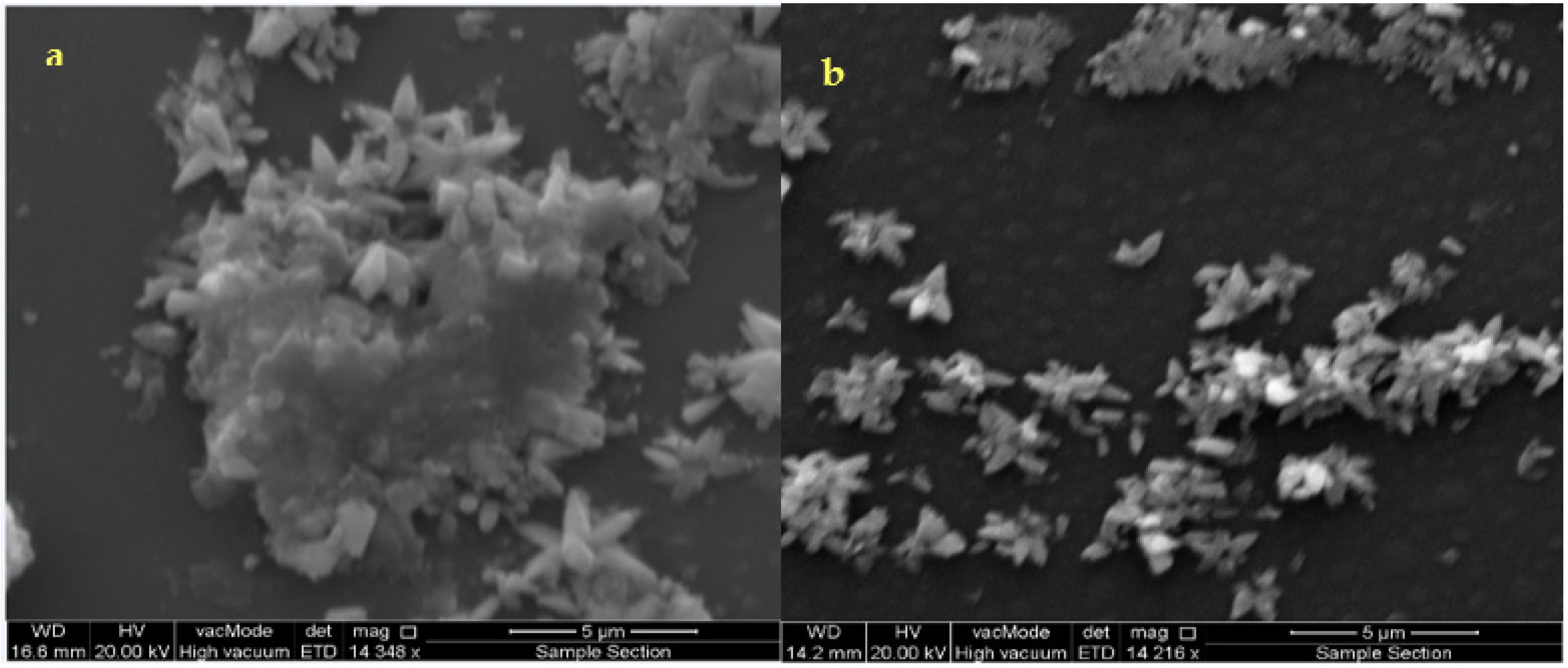
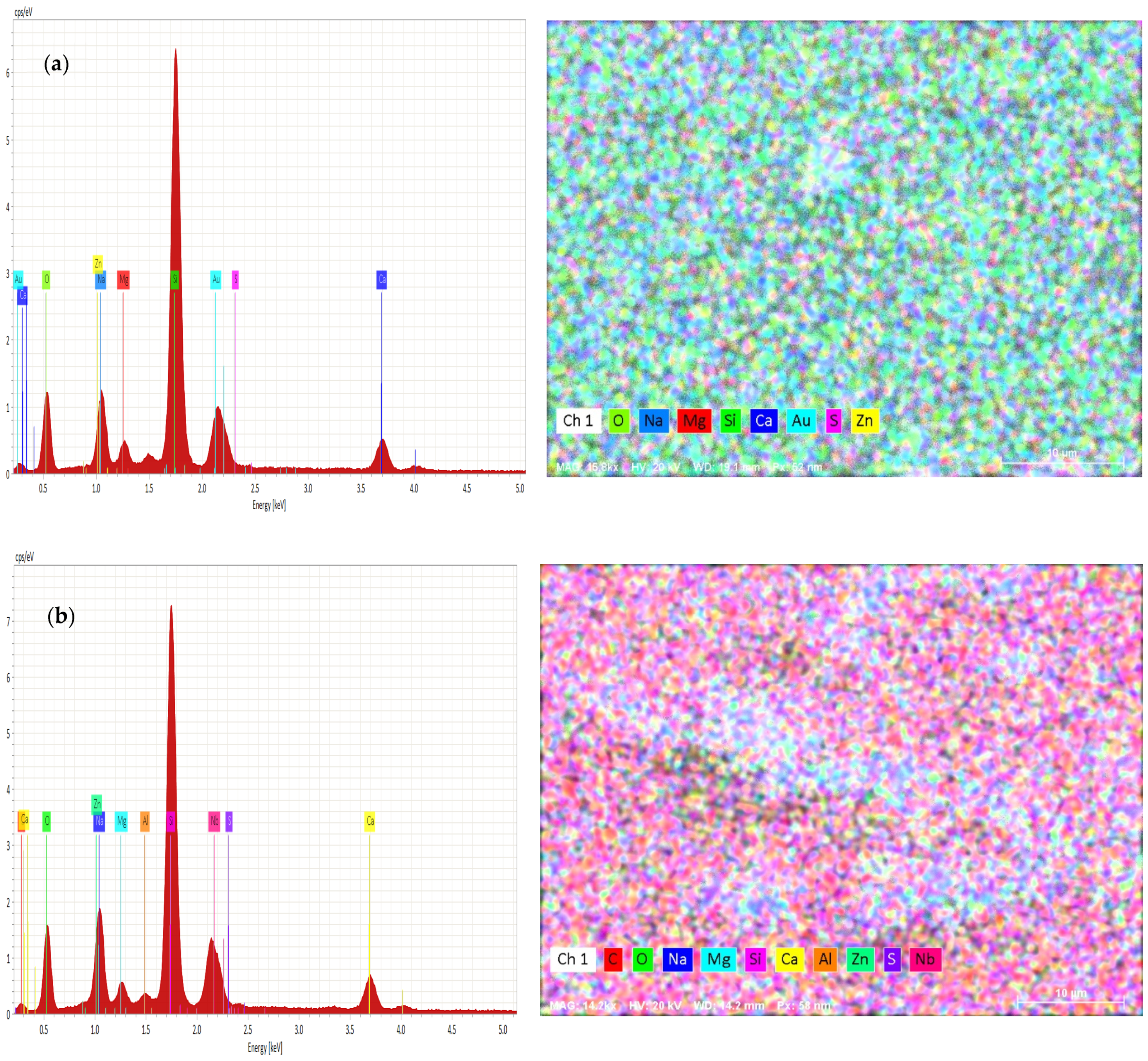
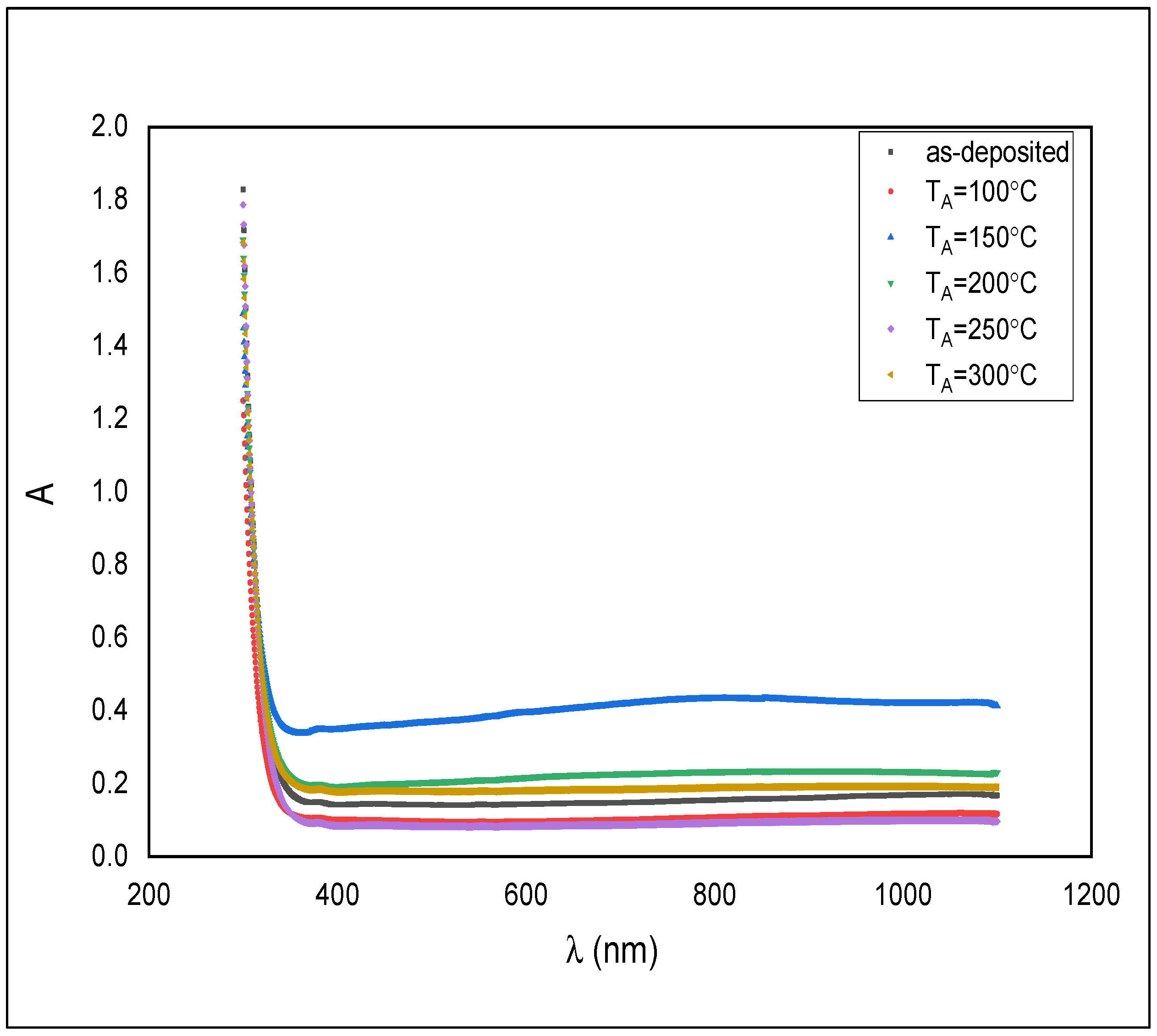
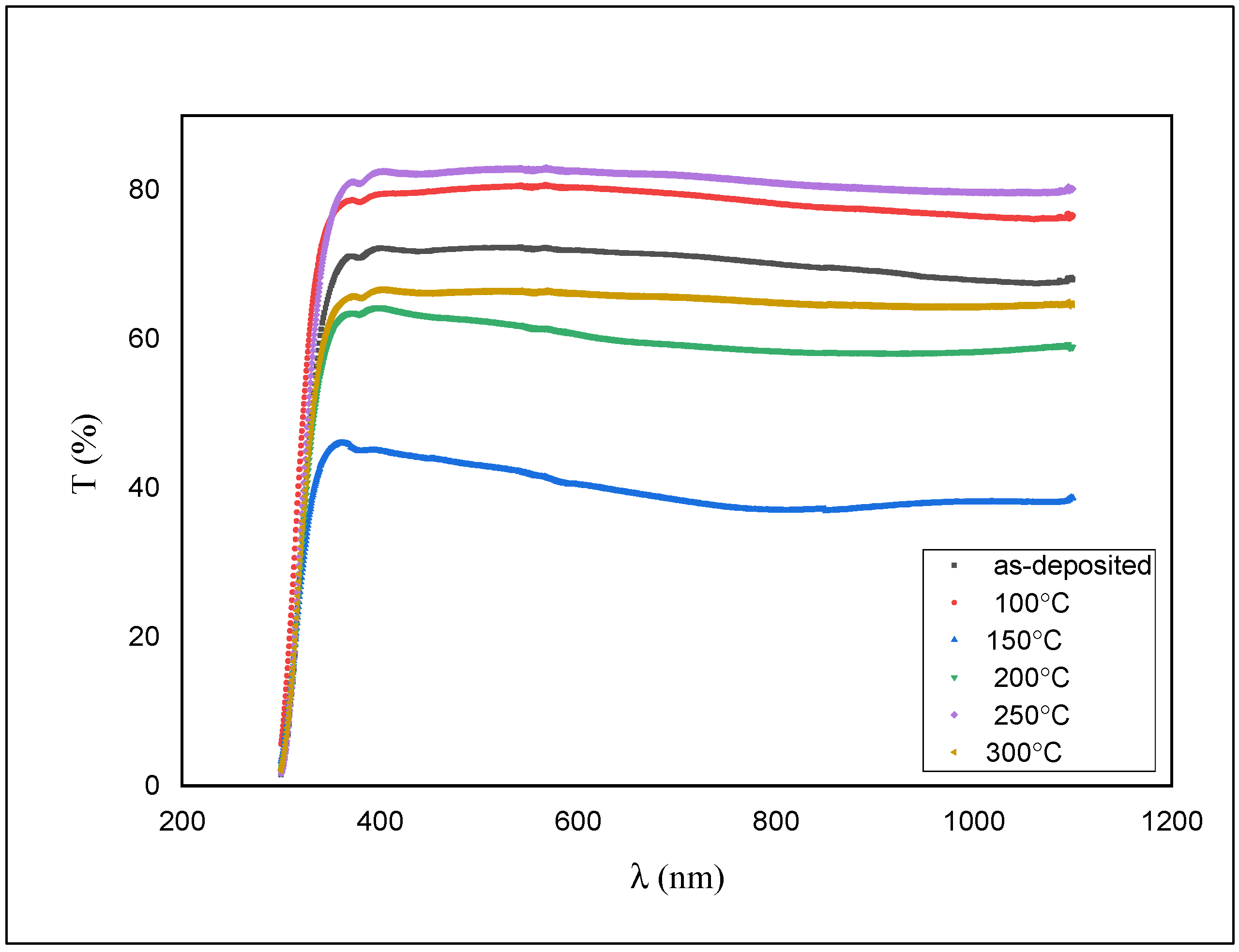

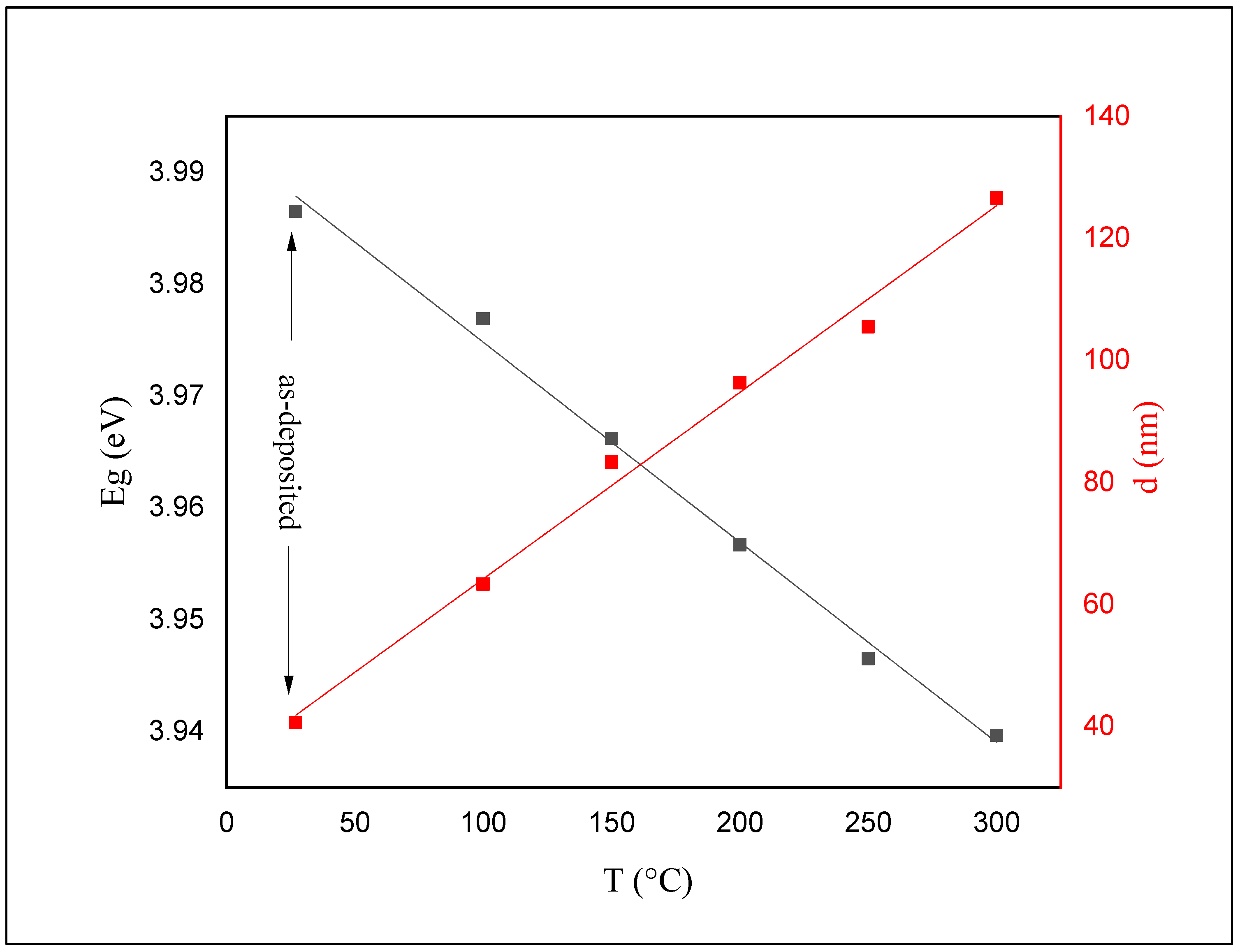
| Annealing Temperature (°C) | D (Å) | D (Å) |
|---|---|---|
| Scherrer equation | Williamson–Hall method | |
| as-deposited | 352.52 | 322.97 |
| 300 | 528.95 | 503.06 |
| Annealing Temperature (°C) | 2θ (Degree) | β | c (Å) | a (Å) | D (Å) | d (Å) | V (Å)3 | δ (Lines/m2) ×10−6 | N ×1014 | ε ×10−4 |
|---|---|---|---|---|---|---|---|---|---|---|
| as-deposited | 34.85 | 0.23 | 5.143 | 2.96 | 352.52 | 2.573 | 246.38 | 8.046 | 9.27 | 9 |
| 300 | 34.82 | 0.157 | 5.148 | 2.972 | 528.95 | 2.576 | 247.08 | 3.574 | 8.55 | 6 |
Publisher’s Note: MDPI stays neutral with regard to jurisdictional claims in published maps and institutional affiliations. |
© 2021 by the author. Licensee MDPI, Basel, Switzerland. This article is an open access article distributed under the terms and conditions of the Creative Commons Attribution (CC BY) license (https://creativecommons.org/licenses/by/4.0/).
Share and Cite
Mohammed, R.Y. Annealing Effect on the Structure and Optical Properties of CBD-ZnS Thin Films for Windscreen Coating. Materials 2021, 14, 6748. https://doi.org/10.3390/ma14226748
Mohammed RY. Annealing Effect on the Structure and Optical Properties of CBD-ZnS Thin Films for Windscreen Coating. Materials. 2021; 14(22):6748. https://doi.org/10.3390/ma14226748
Chicago/Turabian StyleMohammed, Raghad Y. 2021. "Annealing Effect on the Structure and Optical Properties of CBD-ZnS Thin Films for Windscreen Coating" Materials 14, no. 22: 6748. https://doi.org/10.3390/ma14226748






